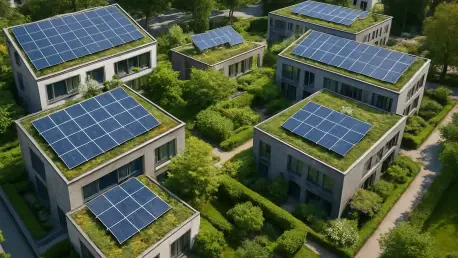In the heart of densely packed urban centers like Singapore, where every square foot of land is a precious commodity, a pioneering study has unveiled an innovative approach to sustainability that could reshape city landscapes. Conducted through a collaboration between the Building and Construction Authority (BCA), National Parks Board (NParks), and the National University of Singapore (NUS), this research explores the potential of integrating solar panels with green roofs on building tops. Traditionally, these two elements have been seen as incompatible due to their competing demands for sunlight, but the findings challenge this notion. Instead, they point to a remarkable synergy that not only tackles the pressing issue of limited space but also amplifies energy efficiency and environmental benefits. This concept promises to turn urban rooftops into dual-purpose hubs, blending renewable energy with natural ecosystems in a way that could redefine how cities operate.
Far from being a simple space-saving trick, this approach offers a multifaceted solution to the challenges of urban density. Cities often face a difficult choice between prioritizing clean energy infrastructure and maintaining green spaces for environmental health. The study suggests that there’s no need to choose—combining solar panels with rooftop greenery can achieve both goals simultaneously. This integration delivers a range of advantages, from producing electricity to cooling buildings, all while making the most of scarce urban real estate. As cities worldwide grapple with land constraints and sustainability targets, such innovative strategies could provide a practical blueprint for balancing growth with ecological responsibility.
Exploring the Synergy of Solar Panels and Green Roofs
Space Efficiency in Urban Environments
The issue of limited space in urban areas stands as a critical barrier to sustainable development, particularly in compact city-states like Singapore where land is at a premium. The research highlights how co-locating solar panels and green roofs offers a compelling way to maximize the utility of rooftops, which are often underutilized. Instead of allocating separate areas for energy generation and greenery, this dual-use model allows both to coexist on the same surface. By stacking these systems, buildings can contribute to renewable energy goals without sacrificing the environmental and aesthetic benefits of vegetation. This approach addresses a fundamental urban challenge: how to integrate essential infrastructure into tight spaces without compromising on livability or sustainability. The findings suggest that such integration could become a standard practice in densely populated regions, turning rooftops into valuable assets for city planning.
Beyond just fitting more onto rooftops, this strategy reimagines how urban spaces can function as multi-purpose environments. The collaboration between solar technology and green infrastructure means that buildings no longer have to prioritize one over the other. Rooftops can simultaneously generate power and support plant life, reducing the need for sprawling ground-level installations that compete with other land uses. This is particularly vital in areas where every inch counts, as it prevents the loss of potential green spaces to industrial or energy projects. Additionally, this method can inspire architectural designs that inherently blend functionality with environmental consciousness, encouraging developers to think beyond traditional building models. As urban populations continue to grow, adopting such space-efficient solutions could be key to maintaining a balance between expansion and ecological preservation.
Energy Generation and Performance Boost
One of the most striking revelations from the study is the enhanced performance of solar panels when paired with green roofs, a result that defies conventional expectations. Typically, solar panels lose efficiency as temperatures rise, a common issue in hot urban environments. However, when installed over greenery, the panels benefit from a natural cooling effect driven by evapotranspiration—a process where plants release water vapor into the air. This lowers the ambient temperature around the panels, allowing them to operate more effectively. The research indicates a noticeable increase in electricity output compared to panels on bare concrete roofs, demonstrating that this combination isn’t just about coexistence but about mutual enhancement. Such findings could push for a rethink in how solar energy systems are deployed in cities with intense heat.
This boost in energy generation carries significant implications for urban power grids, especially in regions aiming to expand renewable energy capacity. The additional electricity produced, even if incremental per building, can add up to substantial gains when scaled across an entire city. For areas with high energy demands and limited space for large-scale solar farms, this approach offers a viable alternative by leveraging existing structures. It also reduces dependency on fossil fuels, aligning with global efforts to cut carbon emissions. Moreover, the cooling effect on solar panels could extend their lifespan by minimizing heat-related wear, providing a cost-effective bonus for building owners. As cities strive to meet sustainability targets, integrating green roofs with solar setups could become a cornerstone of energy planning, transforming urban buildings into active contributors to cleaner power networks.
Additional Benefits for Buildings and Beyond
Thermal Regulation and Cost Savings
Another significant advantage of combining solar panels with green roofs lies in the improved thermal regulation they provide to buildings, a benefit that directly impacts both comfort and expenses. The greenery serves as a natural barrier against direct sunlight, dramatically reducing the heat absorbed by rooftops. This shielding effect lowers surface temperatures and, consequently, the heat transferred to indoor spaces below. As a result, occupants experience greater thermal comfort without the constant need for energy-intensive air conditioning systems. In hot climates where cooling costs can be a major burden, this passive temperature control offers a practical way to enhance livability while curbing utility bills. The research underscores how such systems can make urban structures more energy-efficient, addressing a key concern for property managers and residents alike.
The financial implications of this thermal regulation extend beyond immediate savings on energy costs, influencing long-term building maintenance as well. Lower indoor temperatures reduce the strain on HVAC systems, potentially decreasing wear and tear and extending equipment life. This can translate into fewer repair or replacement expenses over time, making the combined system an attractive investment for developers and owners. Furthermore, buildings with better energy performance often qualify for green certifications or incentives, adding to their market value. In densely built urban areas where heat islands exacerbate temperature challenges, adopting this approach could mitigate environmental stress while offering economic benefits. The dual impact of comfort and cost reduction positions this integration as a smart choice for modern urban architecture, aligning with broader goals of sustainability and fiscal prudence.
Enhancing Urban Biodiversity
Contrary to the assumption that vegetation cannot thrive beneath the shade of solar panels, the study reveals a surprising environmental upside to this integrated system. Shade-tolerant plant species have been shown to not only survive but flourish in these conditions, creating small oases of greenery amidst concrete-dominated cityscapes. This finding challenges traditional urban design paradigms, proving that energy infrastructure and natural ecosystems can support each other. The increased plant coverage on rooftops contributes to restoring biodiversity in areas where green spaces are often scarce, providing habitats for insects, birds, and other small wildlife. Such pockets of nature play a vital role in maintaining ecological balance, even in the most built-up environments, and offer a visually appealing contrast to urban grayness.
The benefits of enhanced biodiversity extend to the broader urban ecosystem, fostering resilience against environmental challenges like pollution and habitat loss. Green roofs, even when partially shaded by solar panels, help filter air pollutants and capture rainwater, reducing runoff and easing the burden on city drainage systems. They also contribute to mitigating the urban heat island effect, where built areas trap and amplify heat, by adding vegetative cover that cools the surroundings. This integration supports municipal efforts to create healthier, more sustainable cities by weaving nature back into the fabric of urban life. For communities, the presence of greenery can improve mental well-being and foster a connection to the environment, even in high-density settings. As urban planning evolves, prioritizing such dual-purpose solutions could help cities become more livable while addressing pressing ecological needs.
Broader Implications for Tropical Cities
The findings from this research hold particular promise for tropical cities, where environmental conditions like high humidity and intense sunlight create unique challenges and opportunities for urban sustainability. The cooling effect of green roofs on solar panels is likely to be even more pronounced in these climates, given the extreme heat that often hampers energy efficiency. This suggests that the benefits observed in Singapore could be replicated or even amplified in other regions with similar weather patterns. For urban centers in the tropics facing land scarcity and energy demands, adopting this integrated model could provide a scalable solution to meet renewable energy goals while maintaining environmental balance. The study serves as a call to action for planners and policymakers to explore how local conditions can enhance the impact of such systems.
Expanding this approach globally requires tailoring it to diverse urban contexts, but the potential for adaptation is clear. Tropical regions often struggle with balancing rapid urbanization with ecological preservation, making this dual system a timely innovation. It offers a way to generate clean energy without sprawling into limited natural areas, preserving landscapes for other uses. Additionally, the promotion of biodiversity through rooftop greenery can support regional conservation efforts, even in densely populated zones. The research paves the way for further studies to refine installation techniques and plant selections suited to varying tropical environments. As cities from Southeast Asia to Latin America look for sustainable growth strategies, this model could inspire a new wave of urban design that harmonizes technology with nature, setting a precedent for resilient and efficient cityscapes worldwide.









